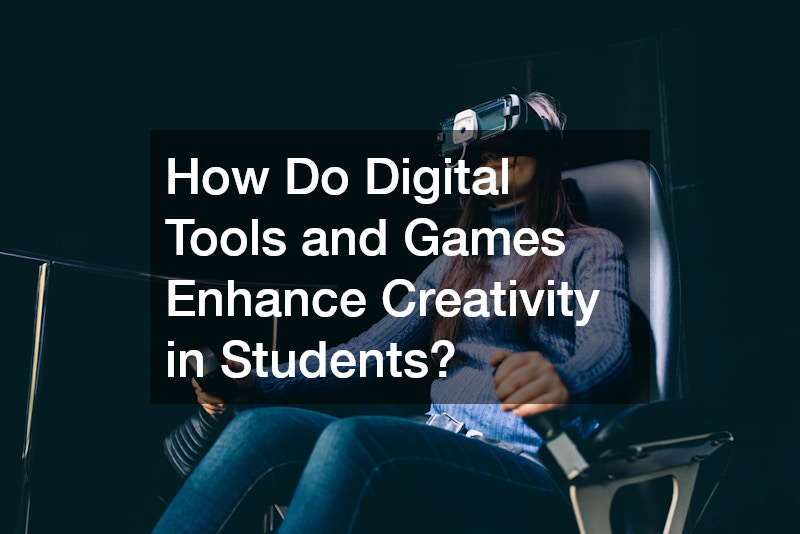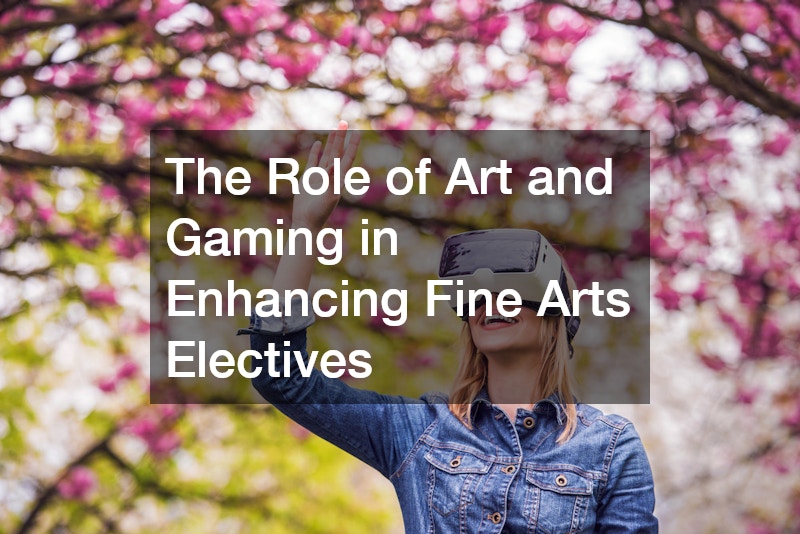
The world of art and gaming is a rapidly evolving field that offers considerable potential for reshaping traditional educational paradigms. The marriage between art and gaming within fine arts electives opens up avenues for enhanced learning experiences, offering fresh perspectives and innovative tools to support artistic development. As educators seek to engage students in more meaningful and enjoyable ways, integrating these elements into the curriculum presents an opportunity to revitalize arts education with cutting-edge concepts.
1. What are Fine Arts Electives and Why are They Important?

Fine arts electives encompass a variety of disciplines within the arts, including visual arts, music, dance, and theater, allowing students the freedom to choose courses aligned with their interests. These electives play a crucial role in the holistic development of students, fostering creativity and critical thinking skills, which are essential in today’s dynamically changing world. By offering diverse experiences, fine arts electives not only enrich the academic environment but also help students discover and cultivate their unique artistic talents.
Moreover, fine arts electives are essential for personal growth, as they nurture emotional intelligence and enhance cultural awareness. These courses inspire students to express themselves more effectively, offering a creative outlet that can be especially beneficial during formative school years. Educational institutions that provide robust fine arts electives contribute significantly to producing well-rounded individuals who are better equipped to tackle complex, real-world challenges.
Additionally, fine arts electives prepare students for various career paths, including those outside traditional artistic roles, like custom logos and custom embroider design industries. These electives can lead to opportunities in fields such as art program management or becoming a landscape designer. Fine arts electives often plant the seeds for lifelong learning and appreciation of the arts in broader contexts, including professional coaching service roles or even within preschool settings, where nurturing creativity from a young age is paramount.
2. How Can Gaming Influence Fine Arts Curriculum?
Gaming has gradually been influencing educational environments, with many schools recognizing its power to enhance student engagement and provide interactive learning experiences. When incorporated into fine arts electives, gaming can serve as a dynamic teaching tool to capture students’ interests while expanding their understanding of artistic concepts. This includes not only digital gameplay but also the exploration of storytelling, visual design, and narrative structure within games.
The influence of gaming on fine arts electives is further seen in the development of skills like problem-solving, teamwork, and technical proficiency, particularly useful when considering careers in gaming computer design or fabrications. As students engage with art-themed games, they learn to appreciate the complexities of graphics, shading, and other visual elements that are akin to those found in the visual arts. Gaming can thus act as a bridge, introducing students to these core artistic elements with which they might not traditionally engage.
Moreover, the introduction of gamified learning experiences into fine arts programs encourages students to view art as a multifaceted discipline that evolves alongside technology. This interplay between gaming and fine arts can foster renewed curriculum design, emphasizing interactivity and innovation. By understanding how gaming influences art education, educators can create syllabus frameworks that leverage these synergies, ensuring that students derive maximum benefit from both fields.
3. What Are the Benefits of Incorporating Art-themed Games into Education?
Art-themed games stand as a compelling medium in education, offering numerous benefits when integrated into fine arts electives. Firstly, they engage students by transforming traditional learning approaches into interactive experiences that cater to various learning styles. This feature is particularly advantageous for dynamic learners who might struggle with conventional methods but thrive in environments where diverse sensory inputs are encouraged.
These games also provide an excellent platform for developing and practicing skills necessary for careers associated with art, such as becoming a landscaper contractor or working with HVAC companies on spatial design projects. By engaging students through art-themed games, educators cultivate skills like spatial awareness, color theory exploration, and visual planning. Consequently, these games provide a rich context for students to explore and experiment with artistic elements, expanding their ability to conceptualize and execute creative projects.
Additionally, the integration of such games into education promotes collaboration and teamwork, as they often require players to work together to achieve objectives. This team-oriented approach mirrors the collaborative nature of professional artistic projects, such as those involved in creating custom logos or working on custom embroider patterns. As a result, these games teach students valuable lessons about teamwork, communication, and project management, all of which are essential in the context of modern artistic and professional challenges.
4. How Do Digital Tools and Games Enhance Creativity in Students?

Digital tools and games offer limitless possibilities for enhancing creativity, providing students with novel ways to express their ideas and explore various artistic disciplines. In fine arts electives, these tools break the confines of traditional media, widening the scope for creative exploration and innovation. By leveraging digital platforms, students can create visual art pieces, music compositions, and animated sequences that exude complexity and creativity beyond the capabilities of traditional art forms.
Creativity is further amplified through game-based learning, where students can visualize art in immersive environments that inspire imaginative thinking. Typically, games stimulate diverse cognitive processes, such as lateral thinking and problem-solving, which are pivotal in creative endeavors. This participation encourages students to think outside the box, fostering the development of novel artistic techniques and styles.
In addition to boosting creativity, digital tools and games offer insights into new career pathways in technology-driven industries, including work with gaming computers or even becoming an art program consultant. These experiences equip students with practical, industry-relevant skills in areas like simulation design, which can enhance their professional prospects and competencies. By embracing digital advancements, fine arts electives prepare students not only for artistic pursuits but also for a future where creativity and technology converge.
5. What Are the Challenges in Merging Gaming with Fine Arts Electives?
While integrating gaming into fine arts electives offers numerous advantages, it also presents several challenges that educators must address to implement these technologies effectively. One such challenge is the necessity of ensuring equitable access to technology, as not all students may have the resources to participate in game-based learning experiences. Schools must therefore facilitate access to gaming computers and other necessary digital tools to bridge this digital divide.
There is also the challenge of retaining the integrity of the arts while incorporating gaming elements. Fine arts educators must strike a balance between traditional artistic practices and digital innovations to prevent the overshadowing of foundational handcraft skills like custom embroider designs or traditional landscape art. Keeping traditional art forms relevant and integrated within a digitally enhanced curriculum requires thoughtful curriculum design and adaptation.
Finally, there are pedagogical challenges, as teachers must develop new skills and competencies to effectively integrate gaming into their lessons. Professional development opportunities and coaching services can support educators in acquiring these new proficiencies. As teachers evolve with these tools, they will be able to better direct their curriculum towards student engagement and enhancement of artistic capabilities through gaming experiences.
6. How Can Teachers Effectively Integrate Gaming into Fine Arts Electives?
To effectively integrate gaming into fine arts electives, teachers must take a strategic approach that includes familiarizing themselves with current gaming technologies and understanding their application in artistic contexts. This process involves identifying educational games that complement and enhance existing art curriculum goals, selecting appropriate tools that align with learning outcomes, and ensuring they are accessible to all students.
Teachers can also benefit from forming partnerships with stakeholders, such as gaming professionals or art program developers, to gain valuable insights and support for these integrations. These collaborations can introduce students to industry trends and practices, deepening their understanding of how gaming intersects with artistic disciplines. Inviting guest speakers from diverse fields, including digital illustration or gaming design, can offer valuable real-world perspectives that enrich the educational experience.
Furthermore, educators should foster a classroom environment that encourages experimentation, creativity, and collaboration among students. By promoting a culture that values innovation and critical thinking, teachers can create opportunities for students to explore the synergies between gaming and art. Such an environment enables students to actively engage with course material, building on their cultural empathy and artistic fluency in the process.
7. What Role Does Technology Play in Modernizing Fine Arts Electives?

Technology serves as a catalyst for modernizing fine arts electives, offering innovative pathways for redefining and expanding how art is taught and appreciated. By incorporating digital tools such as graphic design software and virtual reality platforms, educators can challenge traditional notions of what constitutes art and how students interact with it. This shift leads to an increased emphasis on multi-disciplinary artistic experiences that push the boundaries of conventional artistic expression.
Furthermore, technology equips students with the technical skills necessary for navigating careers in industries requiring technical aptitudes, from creating custom logos to working with custom embroider companies. As students learn to embrace technology in their artistic processes, they gain competencies that are applicable to various career paths, including those involving digital artistry and media production.
The modernization of fine arts electives also emphasizes inclusivity by providing new avenues for students to express themselves through non-traditional formats. By incorporating technology into the curriculum, educators can foster a more diverse, equitable learning environment where students from varied backgrounds can access and excel in these programs. This inclusive approach not only enriches the student experience but also cultivates a new generation of artists prepared to engage with a technologically-driven world creatively and constructively.
8. How Do Art and Gaming Collaborations Support Student Engagement?
Art and gaming collaborations often serve as conduits for increased student engagement, transforming fine arts electives into vibrant, immersive learning environments. Through these collaborations, students find opportunities to explore compelling problem-solving scenarios and decision-making processes within the context of creative game design. These opportunities can drive deeper, more meaningful engagement with educational content, enhancing academic performance and personal growth.
These collaborative efforts also cater to a broad spectrum of learners, promoting inclusivity by providing alternative methods for students to interact with artistic content. By integrating gaming elements, educators can engage students who might otherwise be disenchanted with their studies. The result is a more motivated student body that appreciates the value of fine arts within their broader academic and personal lives.
In addition, this collaborative approach to learning helps bridge the gap between education and real-world scenarios. It develops essential 21st-century skills, such as creative problem solving, communication, and collaboration, preparing students for roles as future innovators, whether as landscape designers forging harmonious environments or as developers in gaming computer design. This educational model ensures that fine arts electives are not only a site of artistic exploration but also a foundational platform for a lifetime of learning and achievement.
9. What Examples Exist of Successful Integration of Art and Gaming?
There are several successful instances of art and gaming integration within educational settings that demonstrate how these disciplines can complement and enhance one another. One notable example is the use of virtual reality (VR) game design software in art programs that allow students to bring their artistic visions to life in immersive environments. This use of VR represents a significant step toward merging digital experiences with art education, providing a platform for dynamic, interactive learning.
An educational initiative that specifically incorporates gaming into fine arts electives includes the gamification of art history through interactive, narrative-driven adventures. By navigating historical periods as avatars, students encounter and learn about significant artistic movements and figures, thereby invigorating traditional curriculum content. This approach not only enhances knowledge retention but also instills a deeper appreciation for art history.
10. What Future Trends in Art and Gaming Could Impact Fine Arts Electives?

The future of fine arts electives is poised to be significantly impacted by emerging trends in the intersection of art and gaming, as these fields continue to evolve in unison. One notable trend is the increasing prevalence of augmented reality (AR) applications in classrooms, allowing students to overlay artistic works into their physical environments. This advancement offers immersive, hands-on experiences that can enhance traditional art appreciation courses.
Another intriguing future direction involves the use of artificial intelligence (AI) in creating interactive art pieces, enabling students to engage with art on a multi-sensory level. This technology supports an increasingly personalized learning experience, offering students customization options that align more closely with their interests and artistic preferences. Whether it’s through personalized learning journeys or the creation of custom logos for student projects, AI can catalyze a new era of creativity in fine arts electives.
